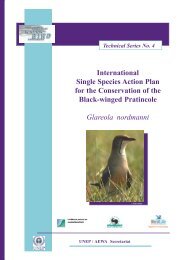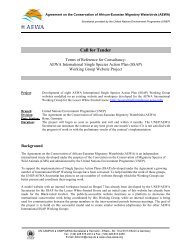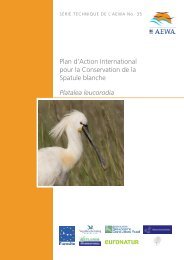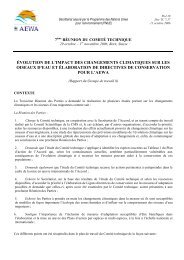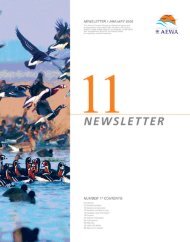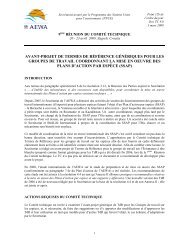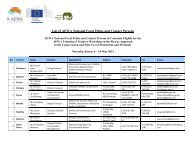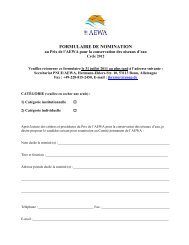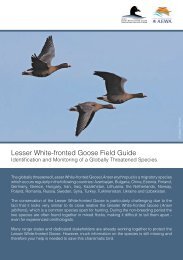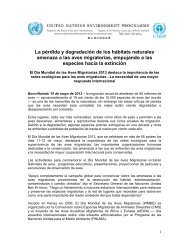International Single Species Action Plan for the ... - AEWA
International Single Species Action Plan for the ... - AEWA
International Single Species Action Plan for the ... - AEWA
Create successful ePaper yourself
Turn your PDF publications into a flip-book with our unique Google optimized e-Paper software.
<strong>AEWA</strong> Technical Series No. 36 - Annexes<br />
Article 5.1<br />
“The Contracting Parties shall consult with each o<strong>the</strong>r about implementing obligations<br />
arising from <strong>the</strong> Convention especially in <strong>the</strong> case of a wetland extending over <strong>the</strong> territories<br />
of more than one Contracting Party or where a water system is shared by Contracting<br />
Parties. They shall at <strong>the</strong> same time endeavour to coordinate and support present and future<br />
policies and regulations concerning <strong>the</strong> conservation of wetlands and <strong>the</strong>ir flora and fauna.”<br />
(i) Convention on <strong>International</strong> Trade in Endangered <strong>Species</strong> of Wild Flora and Fauna<br />
(CITES 1973)<br />
Lesser White-fronted Goose is not included in any of <strong>the</strong> appendices to this Convention.<br />
(j) European Union policies and instruments not specifically dealing with species/habitat<br />
conservation but offering opportunities <strong>for</strong> enhanced management of Lesser Whitefronted<br />
Goose habitats<br />
The EU’s principal nature conservation legislation is made up of <strong>the</strong> Birds and Habitats’<br />
Directives, some provisions of which are outlined above. The development of <strong>the</strong> ‘Natura<br />
2000’ network of Special Protection Areas (SPAs) and Special Areas of Conservation (SACs)<br />
has been <strong>the</strong> main focus in recent years and has been supported by <strong>the</strong> EU’s financial<br />
instrument <strong>for</strong> nature conservation LIFE–Nature. Both Natura 2000 and LIFE have made<br />
important contributions to Lesser White-fronted Goose conservation. However, <strong>the</strong>re o<strong>the</strong>r<br />
EU policies and instruments that could be used to achieve potentially more significant<br />
progress at <strong>the</strong> landscape scale. Three are highlighted below.<br />
Common Agriculture Policy<br />
The partial re<strong>for</strong>m of <strong>the</strong> CAP, including <strong>the</strong> introduction of <strong>the</strong> Rural Development<br />
Regulation (2000-2006) offers opportunities <strong>for</strong> “a prominent role [to] be given to agrienvironment<br />
instruments to support <strong>the</strong> sustainable development of rural areas and to respond<br />
to society’s increasing demand <strong>for</strong> environmental services”. Agri-environment measures<br />
represent <strong>the</strong> only compulsory rural development instrument that Member States MUST<br />
implement. ‘Less Favoured Areas’ compensation, wetland restoration, extensive farming, and<br />
reversion of arable land to grasslands are all management measures that could be targeted.<br />
The drawback to date has been <strong>the</strong> relatively small budget <strong>for</strong> <strong>the</strong> RDR in comparison with<br />
CAP market subsidies (10% versus 90%). In July 2004 <strong>the</strong> European Commission published<br />
its proposals <strong>for</strong> revision of <strong>the</strong> RDR to cover 2007 to 2013.<br />
• <strong>the</strong> establishment of a special fund, <strong>the</strong> European Agricultural Fund <strong>for</strong> Rural<br />
Development (EAFRD), separate from <strong>the</strong> normal CAP mechanisms, with simpler<br />
financial rules;<br />
• a requirement <strong>for</strong> European and national strategy documents;<br />
• three priority axes <strong>for</strong> spending (I – improving <strong>the</strong> competitiveness of <strong>the</strong> agricultural and<br />
<strong>for</strong>estry sector; II – land management including animal welfare; and III – diversification<br />
of <strong>the</strong> rural economy and <strong>the</strong> quality of life in rural areas), with detailed measures under<br />
each axis;<br />
• a requirement that a minimum of 25% of Community support <strong>for</strong> each rural development<br />
programme is spent on axis II (land management), and that a minimum of 15% is<br />
committed to each of <strong>the</strong> o<strong>the</strong>r two axes;<br />
• <strong>the</strong> existing LEADER (funding <strong>for</strong> local action groups in rural communities) financial<br />
instrument to be ‘mainstreamed’ within <strong>the</strong> RDR and a minimum 7% of funding <strong>for</strong><br />
LEADER within rural development programmes;<br />
• a mechanism <strong>for</strong> revising <strong>the</strong> designation of Less Favoured Areas; and<br />
<strong>International</strong> <strong>Single</strong> <strong>Species</strong> <strong>Action</strong> <strong>Plan</strong> Lesser White-fronted Goose –Annexes<br />
XLV



